I used to have a LAWN, now I have a NATURAL environment
I also have a sanctuary, a small enclosed garden, away from the “natural” environment I designed. My twitter friend @InterLeafer already has the “Sanctuary” title and a great post to go with it. This is all about a “Lawn Reform” movement, a new website and a great promotion via Blue Planet.
In recent years my Landscaping design has focused almost exclusively on low maintenance, drought resistant plantings and designs requiring no or minimal environmental pollutants to foster success. This is very different from where I grew up in the UK, and also to what I focused on years ago: when we masterminded extensive lawns framed by 120 foot serpentine perennial beds or multiple 100 foot Herbaceous borders, with dramatically evolving color palettes as the seasons changed ~ very labor and nutrient intensive. I am so glad my focus has changed ☺
When we go into a new area we start by understanding what the local environment really looks like ~ and what it looks like through the changing seasons.
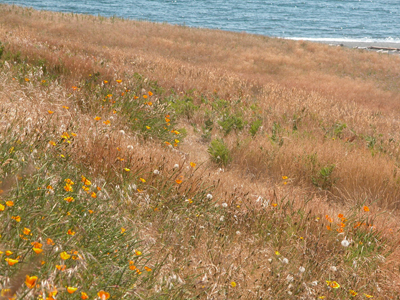
Wild grasses hold sway in the salt-tinged wind, green in the spring, gold in summer, sprinkled with California poppies. The San Juan Islands, located in the Pacific North West, boast a variety of “grassy” natural environments, perfect for us to imitate in our landscaping designs.
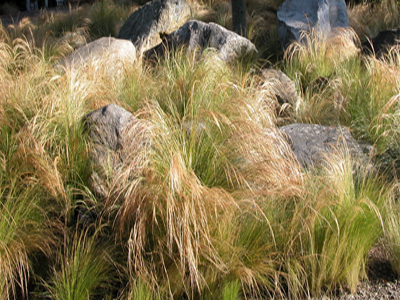
In the beginning, rocks discarded from a neighboring construction site were brought in, and arranged as though by Nature herself. Mexican Feather Grass was planted prior to the winter rains.
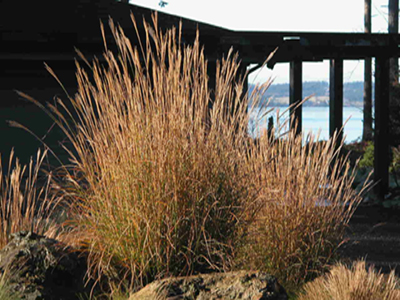
Several species of Miscanthus Sinensis were planted amidst the sea of feather grass and our rocky outcroppings.
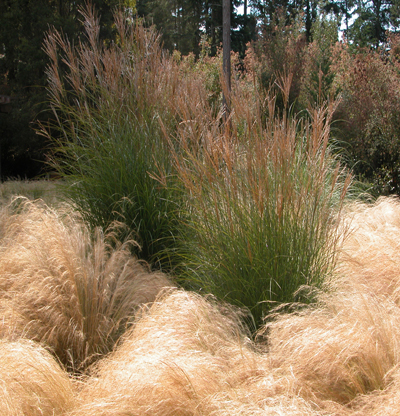
The feather grass turns fluffy and golden at summer’s end; the flowing motion created by gentle breezes or the more vigorous winds off the water adds considerable drama after the long hot lazy sunny summer days.
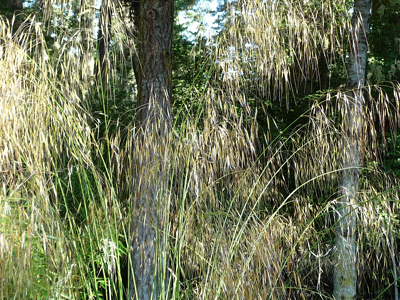
Gigantic feather grass, growing over eight feet, is like a gigantic lace curtain separating spaces within the “natural” environment we created.
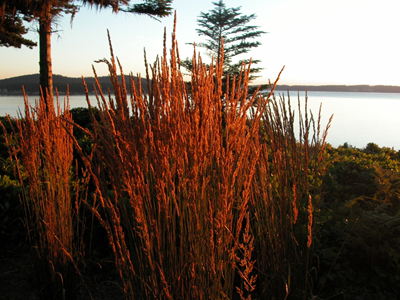
Reed feather grass, also called Karl Foester, resembles the grass we see all along the island road sides. It is one of our favorites, as it flourishes wherever planted, even on the bluffs taking on the salt and wind.
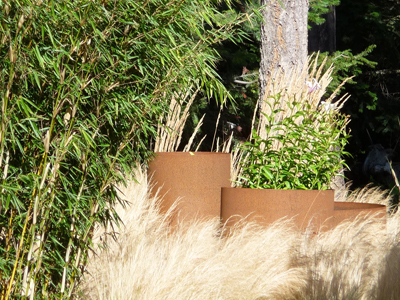
Custom designed steel planters, with their ‘patina of rust’, emerge from the feather grass as though from some former industrial artifact.
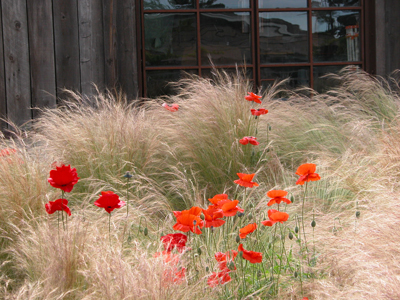
Patty, the owner of the island’s best resource Islandscape, suggested I plant the European poppy ~ Legion of Honor ~ propagated by seed, instead of the closer to home California poppy. “These red poppies are controllable if they get out of hand”, Patty said, “however the California poppies with extensive root systems are perennials and very difficult to eradicate or control when they take over, and they will”. I wanted to simulate the “natural” environment by bringing in the actual plants from the surrounding area, however, she advised against digging up the local roadside or beach grasses. Though perfectly beautiful and suited to my design, they could cause havoc in a controlled ecosystem, destroy my vision and create a maintenance nightmare. She helped me select just the perfect “look alike” to create the final effect I had in mind, and choices that would work in our locale.
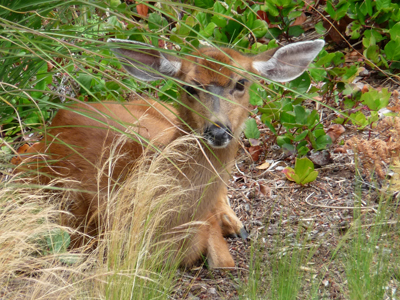
Where Mexican Feather Grass might be invasive if introduced into other areas, in the island climate (and I checked carefully) it is far more docile, really only reseeding its many scattered light green offspring within a few feet. It is really quite well mannered and does does not penetrate the outer edges, which are covered with a heavy layer of the indigenous island Salal. The grasses attract the wildlife and often deer are found resting or even having their young. “Natural” attracts Nature.
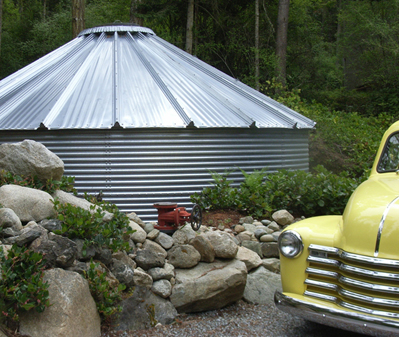
When you design in a new area, it’s important to check with local nurseries, designers, and if possible a meteorologist, to get an understanding of climate and rainfall. Annual rainfall is always a major consideration even when designing “natural” environments with drought tolerant planting. To counteract many summer months without rainfall, rain collection and storage systems are often a viable solution. Wherever possible and local conditions dictate, we recommend and design collection and storage systems for landscaping, often adding filtration for household use.
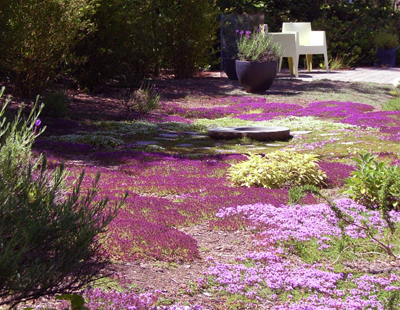
We have designed other “natural” environments including thyme lawns, simulating patches of wild flowers found in woodland glades, attracting layer upon layer of honey bees. These lawns are thirstier than the grasses, and in the island landscape require lots of additional water to keep the blooms from drying out; but on a small scale they are a dramatic contrast of color and well worth the effort and additional water.
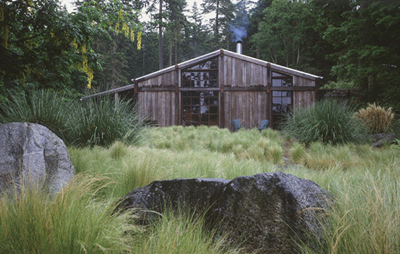
The different coloration and movement of the grass can create “water dragons”, which I have learned carry extremely benevolent energy, and houses which are built in natural environments have some of the very best feng-shui ☺
AND by the way the entire two acres of this “natural” environment project started out as LAWN.
Any comments, suggestions or continuing discussion; please comment below or email me at casudi@esse-group.com.
Caroline Di Diego
@CASUDI
www.inclinedesign.info
INCLINED TO DESIGN





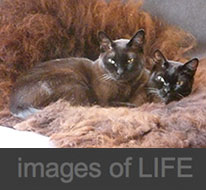


September 16th, 2009 at 3:24 pm
What a stunning design! Your post is a walking advertisement for what is so wrong with lawns – everybody’s landscape ends up looking the same. There’s nothing we can do about the one-design-fits-all housing developments and shopping malls being built, but at least we can reclaim our gardens.
I also like your point about the thyme lawn – yes it’s not as drought tolerant, but you’ve chosen to put extra water where you will get the most benefit for your design and environmental buck.
Thank you for sharing this beautiful post and linking back to my blog.
September 18th, 2009 at 10:45 am
Caroline, I really enjoyed this post. We’ve met on Twitter, but I bet you didn’t know that I’m also a bit of a nature girl. I worked in PR at an arboretum for 5 years, and at a large American museum and garden for 7 years. My yard was mostly lawn when I bought my house, but I had a full sun, very swampy area due to poor drainage. I now have a 15 x 20′ butterfly garden and my own Monarch butterflies. I live on the East Coast of the USA.
I didn’t feel like I could afford expensive renovation/landscaping to correct the problem (it was ALWAYS too wet to mow due to surrounding property/water runoff issues). Instead I found native swamp plants at a local arboretum/public garden plant sale. Before ordering them, I too did my research to be sure they were not invasive in my area (although the public gardens had done their research as well). It was perfect, they had flats of 30 plants – 5-7 plants each of several varieties for sunny, wet meadows with ‘deep plugs’w/ extra long roots. I’ve added a few other native plants over the years and I now have a thriving natural habitat with bees, various butterflies, lightening bugs.
I have Joe Pye Weed (5-6’ tall), two types of swamp butterfly weed (milkweed)- the only food that the Monarch butterflies eat, turtle-head, 2 types of Swamp Hibiscus, plus a couple of shrubs and small tree as well. Sorry I don’t have the botanical names with me, and I know common names can be different in different areas.
One year I didn’t cut down the plant stems – the next spring birds were stripping the stems for their nesting – which was an extra treat.
But it solved my mowing issues, has created habitat for butterflies and birds, and looks great, especially in July through September – just a riot of pink. I enjoyed the virtual walk through your article above; I would love to expand the area and get rid of some more lawn add some of the grasses that can handle ‘wet feet.’
September 19th, 2009 at 7:27 am
Absolutely beautiful. I love your focus on low-maintenance, drought-resistant plants; the flow of the feather grass must be mesmerizing when the wind blows through it. This design seems ridiculously fitting for the area and architecture behind it, and I’m just blown away. I mean, I’ve seen other designs of yours and been equally blown away, but this landscape design is stunning. I’ll wish that one day I’ll have the land and space to design and plant a “natural environment” as equally beautiful (probably won’t happen since I don’t have your expertise or talent for design!).
September 19th, 2009 at 8:06 am
Susan, thanks for your comment. This post was a great deal of fun to write almost as much as the landscaping was to implement.
Years ago I was involved in a Xeriscape project for developments (housing tracts in the desert)in Reno, initiated by the power company no less. These developments have no business having lawns do they? And recently I have seen some great shopping center landscaping designs in the North West using very much the same grasses I did. However these shopping center designs could be improved if they planted in categories of grasses, masses of the same like in nature, rather then try to use the grasses in what would be a traditional ” mixed media” landscaping style.
Cathy, I might have guessed about you! Thanks for a great comment giving many specifics of how you did the East coast equivalent to our “natural environment”. Swampy problems are ideal for this focus once you solve what the right plantings are, those which allow their roots to be in water some or all of the time. We don’t have this problem in the summer where we often don’t get rain from May-October, and have a sandy well drained soil, however in November when we get most of our winter rain we can have a very wet environment and can lose plantings through rot. It’s a all a delicate balance just like Social Media. I was told people don’t like the technical or Latin names in posts and will look them up if important to them, so common names are just fine and BTW I could totally visualize your natural creation, Monarch butterflies and all.
September 19th, 2009 at 10:11 am
Love the photo of the thyme lawn. Although I was never interested in the manicured lawn look, I too was enamored by the English perennial gardens. Although Rochester NY is not lacking for rain or humidity, perennial gardens of this nature are definitely a labor of love. I re-did my perennial border last year and planted more structural plants that had interest all year long, I can spend a lot more time relaxing and enjoying my garden rather then laboring over it. I do not miss staking the 5 foot tall sky blue delphiniums as beautiful as they were.
As for the “lawn”, we enjoy the ground covers that grow with the grass. Having pets and kids, a lawn was always a nice place for the feet. We would dig out the occasional obnoxious “weed” with a hand tool. Our time tested recipe for having a low maintenance lawn is to sow grass seed each spring and fall and fertilize the hell out of it. We have been using a product called Milorganite for decades..the grass grows vigorously and naturally crowds out other weeds.
One more gardening tip that I agree with you on is getting your supplies from reputable local nurseries. These people know the particular varieties of plants that will grow well in your area and you can hand select your plants to know you are starting out with good healthy stock
Happy Gardening to Y’All
September 19th, 2009 at 4:34 pm
Teresa, thanks so much for your fab comment, it passed my last comment in cyberspace! One of my favorite blog posts recently was one of yours as guest poster for Marketing Guru Beth Harte, and in many ways “Gardening … the Social Media Way” is relevant to real life gardening as well a great take on social media. I recommend this to both gardeners and to those in Social Media.
Robin, I too have spent time gardening on the East Coast prior to moving out west, however I tried to replicate a level of perfection unobtainable given the East Coast climate! In fact when I first moved away, I gave up gardening all together for myself. Then the opportunity arose to move to the San Juan Islands, an opportunity I was unable to resist and there I was facing a Lawn again! So I created an enclosed little garden sanctuary outside my office, which I can keep as perfect as humanly possible, surrounded by the natural environment I cover in my post. Thanks so much for commenting and sharing your gardening experiences.
January 6th, 2010 at 8:19 pm
This is absolutely inspiring. Hands-down some of the best photography of ornamental grasses I’ve seen, and I LOVE that thyme meadow… Gorgeous.
January 7th, 2010 at 5:54 pm
Caroline, I found your blog through your website, and am so glad to have seen this post. Your use of ornamental grasses and their movement with nature is truly beautiful. So many different types, I think I like your 4th picture the best. I love your thyme lawn area, the colors really stand out. I have used it between many types of flagstone paths, with no water added, and it really thrives in Colorado. Thanks for this fabulous post.
January 7th, 2010 at 9:12 pm
Genevieve and Kathy, thanks so much for commenting on my landscaping post. Both of you have great Blogs with really valuable information. I am really passionate about “natural” landscaping and eliminating the water gulping plants from the mix. Also high on my list is designing to the available resource, taking into consideration the local nurseries who stock what is appropriate to an area. Sometimes it does take a bit of education to persuade a client they should not have their fantasy lawn in the desert.
when I visualized the feather grass, I imagined it to be a SEA of grass rippling in the wind. So the fourth image down you mention, exactly illustrates my vision or fantasy.
February 8th, 2010 at 3:20 pm
[…] (90’s)….designed online learning (2000)…..designed residential interiors and landscapes.…..designed art and antiquities collections for investment……mentored entrepreneurs […]
October 26th, 2011 at 2:00 pm
[…] (90′s)….designed online learning (2000)…..designed residential interiors and landscapes.…..designed art and antiquities collections for investment……mentored entrepreneurs […]
April 29th, 2012 at 11:59 am
Caroline the landscape and site looks incredible thanks for sharing now I can picture your serene setting when we chat. Although all of the planning and beauty is beautiful what caught my eye was the classic chevy pickup what a vehicle, even with only a fender view it appears to be immaculate!